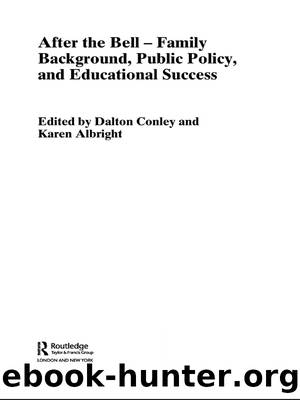After the Bell by Albright Karen;Conley Dalton;

Author:Albright, Karen;Conley, Dalton; [DALTON CONLEY AND KAREN ALBRIGHT]
Language: eng
Format: epub
Publisher: Taylor & Francis Group
Published: 2011-09-29T00:00:00+00:00
Notes
1 Direct correspondence to Jean Yeung at [email protected] or Room 445, 269 Mercer Street, New York University, New York, NY 10003. Funding for this research is provided by a grant from the National Institute of Child Health and Human Development (R03 HD38860â02).
2 See J. H. Pleck, âPaternal involvement: levels, sources, and consequences,â in The Role of the Father in Child Development, New York, NY: John Wiley & Sons, 1997 for a review of work on fatherhood.
3 See A. C. Acock and D. H. Demo, Family Diversity and Well-Being, Thousand Oaks, CA: Sage, 1994; H. B. Biller, Fathers and Families: Paternal Factors in Child Development, Westport, CT: Auburn, 1993; K. M. Harris and S. P. Morgan, âFathers, sons, and daughters: differential paternal involvement in parenting,â Journal of Marriage and the Family 53, 1991, 531â544; and R. LaRossa, âFatherhood and social change,â Family Relations 37, 1988, 451â458 for evidence of lower involvement of fathers.
4 See S. Bianchi, âMaternal employment and time with children: dramatic change or surprising continuity?,â Demography 37, 2000, 401â414; M. E. Lamb, J. H. Pleck, E. L. Charnov, and J. A. Levine, âPaternal behavior in humans,â American Zoologist 25, 1985, 883â894; J. H. Pleck, Working Wives, Working Husbands, Beverly Hills, CA: Sage, 1985; Pleck, op. cit.; W. J. Yeung, J. F. Sandberg, P. E. Davis-Kean, and S. L. Hofferth, âChildrenâs time with fathers in intact families,â Journal of Marriage and Family Review 63, 2001, 136â154 for evidence of increase in paternal involvement over the past few decades.
5 Examples of such studies include V. W. Knox and M. Bane, âChild support and schooling,â in Child Support and Child Well-Being, edited by I. Garfinkel, S. S. McLanahan, and P. K. Robins, Washington, DC: Urban Institute, 1994, 285â316; V. King, âNonresident father involvement and child well-being: can dads make a difference?,â Journal of Family Issues 15, 1994, 78â96; and S. S. McLanahan, J. A. Seltzer, T. L. Hanson, and E. Thomson, âChild support enforcement and child well-being,â in Child Support and Child Well-Being, edited by I. Garfinkel, S. S. McLanahan, and P. K. Robins, Washington, DC: Urban Institute, 1994, 239â256.
6 J. S. Coleman, E. Campbell, C. Hobson, J. McPartland, A. Mood, F. D. Wein-feld, and R. York, Equality of Educational Opportunity, Washington DC: Department of Health, Education and Welfare, 1966; C. S. Jencks, M. Smith, M. Bane, D. Cohen, H. Gintis, B. Heyns, and S. Michelson, Inequality: A Reassessment of the Effect of Family and Schooling in America, New York, NY: Basic Books, 1972; C. S. Jencks, S. Bartlett, M. Corcoran, J. Crouse, D. Eagles-field, G. Jackson, K. McClelland, P. Mueser, M. Olneck, J. Schwartz, S. Ward, and J. Williams, Who Gets Ahead? The Determinants of Economic Success in America, New York, NY: Basic Books, 1979.
7 U.S. Department of Education, âA Nation At Risk: The Imperative for Educational Reform,â http://www.ed.gov/pubs/NatAtRisk/index.html, 1983.
8 P. D. Forgione, âThird international mathematics and science study,â National Center for Educational Statistics, U.S. Department of Education, Washington, DC, 1999.
9 J. S. Eccles, A. Wigfield, and U. Schiefele, âMotivation,â in Handbook of Child Psychology, vol.
Download
This site does not store any files on its server. We only index and link to content provided by other sites. Please contact the content providers to delete copyright contents if any and email us, we'll remove relevant links or contents immediately.
The Meaning of the Library by unknow(2385)
Six Billion Shoppers by Porter Erisman(2227)
Why Nations Fail: The Origins of Power, Prosperity, and Poverty by Daron Acemoglu & James Robinson(2176)
No Time to Say Goodbye(1997)
Red Notice by Bill Browder(1927)
The Economist [T6, 22 Thg9 2017] by The Economist(1843)
Currency Trading For Dummies by Brian Dolan(1789)
Thank You for Being Late by Thomas L. Friedman(1679)
Bitcoin: The Ultimate Guide to the World of Bitcoin, Bitcoin Mining, Bitcoin Investing, Blockchain Technology, Cryptocurrency (2nd Edition) by Ikuya Takashima(1613)
Amazon FBA: Amazon FBA Blackbook: Everything You Need To Know to Start Your Amazon Business Empire (Amazon Empire, FBA Mastery) by John Fisher(1496)
Coffee: From Bean to Barista by Robert W. Thurston(1419)
The Future Is Asian by Parag Khanna(1401)
The Great Economists by Linda Yueh(1390)
Capitalism Without Capital: The Rise of the Intangible Economy by Jonathan Haskel(1341)
Pocket World in Figures 2018 by The Economist(1329)
How Money Got Free: Bitcoin and the Fight for the Future of Finance by Brian Patrick Eha(1322)
Grave New World by Stephen D. King(1315)
The Sex Business by Economist(1279)
Cultural Intelligence by David C. Thomas(1203)
